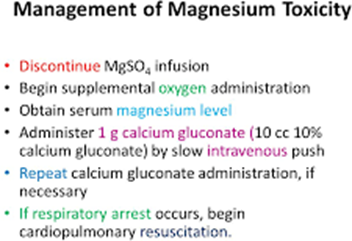A woman with severe preeclampsia has been receiving magnesium sulfate by intravenous infusion for 8 hours. The nurse assesses the woman and documents the following findings: temperature of 98.1F, pulse rate of 96 beats/min, respiratory rate of 10 breaths/min, blood pressure (BP) of 135/90 mm Hg, 1+ deep tendon reflexes, and not ankle clonus. The nurse calls the physician, anticipating an order for:
Select one:
Diazepam.
Hydralazine orally twice a day.
Calcium Gluconate
Second bolus of Magnesium sulfate.
The Correct Answer is C
a. Diazepam is not indicated for the treatment of severe preeclampsia.
b. Hydralazine orally twice a day is not indicated for the treatment of severe preeclampsia.
c. Calcium Gluconate is indicated for the treatment of hypermagnesemia, which can occur as a result of magnesium sulfate infusion.
d. This will worsen the magnesium toxicity.

Nursing Test Bank
Naxlex Comprehensive Predictor Exams
Related Questions
Correct Answer is C
Explanation
a. The client should also be placed in Trendelenburg or knee-chest position to reduce cord compression.
b. This is not the first action to take when the umbilical cord is prolapsed.
c. This is a medical emergency that requires immediate intervention to prevent fetal hypoxia and death. The nurse should insert a gloved hand into the vagina and apply upward pressure on the presenting part to lift it off the cord until delivery.
d. This may be necessary if the cord compression cannot be relieved, but the first priority is to relieve the cord compression.
Correct Answer is C
Explanation
a. A positive CST indicates late decelerations that persist in more than 50% of the contractions, which is not the case in this scenario.
b. A negative CST indicates the absence of late decelerations, which is not the case in this scenario.
c. A satisfactory CST indicates that there are no late decelerations, and the test is considered normal.
d. Reactive is not a term used to interpret a CST.
Whether you are a student looking to ace your exams or a practicing nurse seeking to enhance your expertise , our nursing education contents will empower you with the confidence and competence to make a difference in the lives of patients and become a respected leader in the healthcare field.
Visit Naxlex, invest in your future and unlock endless possibilities with our unparalleled nursing education contents today
Report Wrong Answer on the Current Question
Do you disagree with the answer? If yes, what is your expected answer? Explain.
Kindly be descriptive with the issue you are facing.
